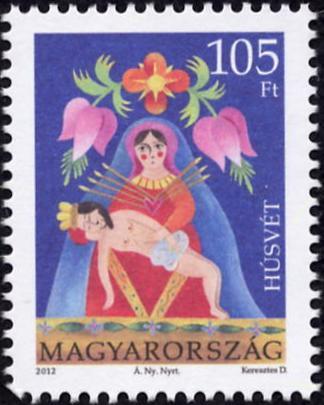
1. MAGYAR - Húsvét 2012 - Bélyeg rendelési kód: 2012 év bélyegei kompletten
2. ENGLISH - Easter 2012 - Order code of the stamp: 2012 Year stamps complete
3. GERMAN - Ostern 2012 - Die Bestellnummer Der Marke: 2012 Jahr Briefmarken komplett
1. MAGYAR - Húsvét 2012
Forgalmi bélyeg jelenik meg az idei Húsvéthoz kapcsolódóan is
A posták lakossági levél- és képeslapforgalma jellemzően évente kétszer, a karácsonyi és a húsvéti ünnepek alkalmával jelentősen megnő. A magyar filatéliai hagyományok mellett ez is arra ösztönzi a Magyar Postát, hogy évente új bélyeg kibocsátásával köszöntse a kereszténység legnagyobb ünnepét. A Magyar Posta filatéliai újdonsága Keresztes Dóra grafikusművész tervei szerint az Állami Nyomdában készült, és február 24-én, Spányi Antal püspök jelenlétében a Magyar Katolikus Rádió épületében hozta forgalomba Bakati Gábor vezérigazgató-helyettes.
A Jézus Krisztus kereszthalálával és feltámadásával beteljesedő megváltás a keresztény örömhír legfontosabb üzenete. A bélyegképen népies ábrázolásmódban a keresztről levett Krisztust ölében tartó és fiát sirató Mária, a pietá jelenet látható. Az alkalmi borítékot a barokk népi hagyományokat és a népi vallásosságot jellemző tárgy, a pléhkrisztusok ihlette grafikai kompozíció díszíti. Az alkalmi bélyegzőn a bélyegkép virágmotívuma ismétlődik.
A húsvét, a kereszténység egyik szent ünnepe, úgynevezett mozgó ünnep. Napja a tavaszi holdtölte utáni első vasárnapra esik, azaz március 22-e és április 25-e közé. A magyar húsvét kifejezés a nagyböjt, azaz az előkészület és önmegtartóztatás idejének elmúltára utal. A tradicionális húsvéti körmenet elnevezése Csíkménaságon „kikerülés”, de más vidékeken az elnevezések inkább a feltámadáshoz kapcsolódnak. A keresztény egyház szertartásaiban hosszú ünnepi időszak fogja át a kora tavasz és a nyár elejei hónapokat. A húsvéti ünnepkör a pünkösddel zárul. (Forrás: unnepnap-munkaszuneti-nap.hu * hu.wikipedia.org)
Forrás: Posta
2. ENGLISH - Easter 2012
Regular postage stamp released for Easter this year
The volume of letters and postcards sent by the public at post offices usually leaps twice every year as part of the festivities at Christmas and Easter. This, as well as Hungarian
philatelic traditions, prompts Magyar Posta to mark Christianity’s major feast by issuing a new stamp each year. Magyar Posta’s philatelic novelty was designed by the graphic artist Dóra Keresztes, made by the state printing company Állami Nyomda and released
on 24 February in the presence of Bishop Antal Spányi in the building of the Hungarian Catholic Radio by Deputy CEO Gábor Bakati.
Redemption through the death by crucifixion and the resurrection of Jesus Christ is the most import-ant message of Christian good tidings. The stamp design employs a folk style to depict the
depos-ition with the mourning Mary holding the body of her son Jesus Christ after he was taken down from the cross. The first day cover is adorned by a graphic composition inspired by baroque folk traditions and an object associated with popular piety, metal outdoor statues of Christ on the cross. The special postmark repeats the floral motif of the stamp design.
Easter is one of Christianity’s holiest days, and is a moveable feast. Easter falls on the first Sunday after the spring equinox, in other words between 22 March and 25 April. The Hungarian word for Easter húsvét conveys the idea of a period of fasting, preparation and abstinence coming to an end by ‘taking meat’, the literal meaning of the word. In Csíkménaság the traditional Easter procession is known as “passover” but in other Hungarian areas it has names connected with the resurrection. The rites of the Christian church span a long festive period in the spring and early summer. The
cycle of feasts linked to Easter ends with Pentecost. (Source: unnepnap-munkaszuneti-nap.hu * hu.wikipedia.org)
3. GERMAN - Ostern 2012
Auch in diesem Jahr erscheint zu Ostern eine Freimarke
Zweimal im Jahr, zu Weihnachten und Ostern, steigt der private Brief- und Ansichtskartenverkehr bezeichnenderweise besonders an. Aus diesem Grund und auch den Traditionen der ungarischen Philatelie folgend begrüßt die Magyar Posta das größte Fest der Christenheit alljährlich mit der Herausgabe einer neuen Briefmarke. Die philatelistische Neuheit der Magyar Posta wurde in der Állami Nyomda nach den Entwürfen der Kunstgrafikerin Dóra Keresztes erstellt und am 24. Februar in Gegenwart des Bischofs Antal Spányi im Gebäude des Ungarischen Katholischen Radios von dem Stellvertretenden Generaldirektor Gábor Bakati eingeführt.
Wichtigste Botschaft des christlichen Evangeliums ist die Erlösung, die durch den Kreuzestod und die Auferstehung Jesu Christi erfüllt wurde. Auf dem Briefmarkenbild ist in folkloristischer Darstellungsform die Pieta zu sehen - Maria, die ihren Sohn, den vom Kreuz genommenen Christus, im Arm hält und beweint. Den Sonderbriefumschlag ziert eine grafische Komposition, inspiriert von den Blechkruzifixen, die aus den volkstümlichen Traditionen des Barocks und der volkstümlichen Religiosität nicht wegzudenken waren. Auf dem Sonderstempel wiederholt sich das Blumenmotiv des Briefmarkenbildes.
Ostern, eines der heiligen Feste der Christenheit, ist ein sogenanntes bewegliches Fest. Das Datum fällt auf der ersten Sonntag nach dem Frühlingsvollmond, also zwischen den 22. März und dem 25. April. Der ungarische Begriff für Ostern „húsvét” („Fleischaufnahme“) zeigt an, dass die Große Fastenzeit, eine Zeit der Vorbereitung und Enthaltsamkeit, zu Ende gegangen ist. Die Bezeichnung der traditionellen Osterprozession in Csíkménaság (heute Rumänien: Armaşeni) ist „kikerülés” („Passah, Vorübergehen“), doch in anderen Landesteilen beziehen sich die Bezeichnungen eher auf die Auferstehung. In den Zeremonien der christlichen Kirchen umfasst ein langer feierlicher Zeitraum die Monate vom Frühjahr bis zum Sommeranfang. Der österliche Festkreis findet mit dem Pfingstfest seinen Abschluss. (Quelle: unnepnap-munkaszuneti-nap.hu * hu.wikipedia.org)










